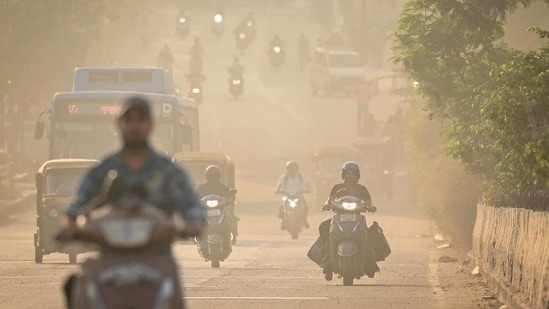Our Terms & Conditions | Our Privacy Policy
Delhi’s toxic air is back, situation likely to worsen in coming days | Latest News India
Smog has set in various parts of Delhi on Saturday morning, with the air quality deteriorating to ‘poor’ and ‘very poor’ categories at a rapid pace over the past few days.
After facing 4 consecutive days of ‘poor’ air quality, the Centre’s air pollution control panel has enforced the Graded Response Action Plan (GRAP) in the city.(Photo: Sanchit Khanna/ HT)
Delhi’s AQI or air quality index has crossed the 300 mark in several areas, as the government grapples with the rising air pollution ahead of winter. In Anand Vihar, Akshardham and its surrounding areas, on Saturday morning, the AQI rose to 334, marking the air quality in the ‘very poor’ category.
A layer of smog was also noticed in several parts of the national capital on Saturday morning. The AQI was recorded at 251 near India Gate, 209 near Nehru Park, 226 near ITO, 273 near Bhikaji Cama Place and 253 near AIIMS, remaining in the ‘poor’ category, according to the Central Pollution Control Board (CPCB).
The first stage of the Graded Response Action Plan (GRAP) restrictions took effect Delhi on October 15 due to the worsening air quality, and measures such as frequent cleaning of roads with water to reduce dust are already underway.
On Friday, October 18, the AQI had hit 292, with the Wazirpur region being the worst affected with a reading of 390. Dust pollution within Delhi and other parts of the National Capital Region (NCR) are key factors making the air quality worse as easterly winds have begun.
Forecasts by the Early Warning System (EWS) for Delhi, predicts that the contribution of stubble burning pollution from Punjab and Haryana is expected to increase over the weekend.
Residents have been complaining of difficulty breathing, cough and various illnesses due to the pollution. Ashish Kumar Meena told news agency ANI, that pollution near the Akshardham region had intensified to the level of causing “choking in the throat, breathing issues and also irritation in the eyes.”
He added, “After Diwali, the pollution levels will increase more. The government needs to take steps to control the level of pollution. People who are burning substances in the fire should be imposed with fines. The ones who have respiratory problems must be suffering so much.”
Another resident proposed that citizens use more public transport or carpool to reduce pollution levels in the city.
An air quality index (AQI) ranging from 0 to 50 is categorised as good, 51 to 100 as satisfactory, 101 to 200 as moderate, 201 to 300 as poor, 301 to 400 as very poor, and 401 to 500 as severe.
Delhi environment minister Gopal Rai on Friday said that AQI had crossed 300 in 13 spots – Wazirpur, Mundka, Rohini, Jahangirpuri, Anand Vihar, Dwarka Sector-8, Bawana, Narela, Vivek Vihar, Okhla Phase 2, Punjabi Bagh, Ashok Vihar and RK Puram.
He also addressed the press and said that the authorities have been instructed to find the local sources behind the worsening air quality. The AAP has faced flak from opposition parties for its failure to control air pollution in the city in it’s ten years tenure.
On Friday, BJP spokesperson Shehzad Poonawalla reached the ‘Smog Tower’ to protest the AAP and its handling of the air pollution crisis, stating that, “Today Delhi has become a gas chamber due to blame game politics of the Aam Aadmi Party. They had made big promises that they would make Delhi pollution-free.”
He also claimed that the AAP had cheated the public by banning firecrackers but locking up the smog tower worth ₹23 crore, making Delhi “the most poisonous and polluted city”.
Images are for reference only.Images and contents gathered automatic from google or 3rd party sources.All rights on the images and contents are with their legal original owners.



Comments are closed.